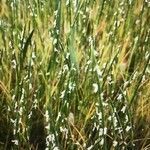Annual, stiff, erect, ± open tufts, (12)-20-35 cm. Leaf-sheath subcoriaceous, glabrous, rounded, ribs ± inconspicuous. Ligule 0.3-0.6 mm, truncate, erose. Leaf-blade 2-6 cm ×c. 2 mm, flat, rolled or folded and < 1 mm diam., abaxially glabrous, adaxially ribbed, with scattered minute hairs on ribs, tip acute. Culm 15-25 cm, tufted or solitary, rigid, usually loosely branched, few-to many-noded, internodes glabrous. Spikes (2.5)-5-12 cm, cylindric, stiffly erect, light green, rachis internodes ≤ spikelets, hollowed on one side, disarticulating horizontally below each spikelet at maturity. Spikelets 4.5-5.5 mm, embedded in cavities in rachis, solitary and alternating on opposite sides of rachis. Glumes ± equal and equalling spikelets, inserted side by side on rachis and appressed to it, 3-5-nerved, rigid, much thickened, narrowly oblong-subulate, acute, hyaline margins minutely papillose. Lemma 4-4.5 mm, ovate-oblong, membranous, 3-nerved, lateral nerves very faint and short. Palea ≈ lemma. Lodicules c. 1 mm. Anthers 2-3 mm. Caryopsis 2.7-3 × 0.6-0.8 mm, enclosed between hardened glumes and segments of rachis.
More
Culms 5–48 cm high. Leaf blade 1.6–12.5 cm long, 0.4–0.9 mm wide. Spikes straight, 1–14 cm long. Bisexual spikelets 3.8–6.8 mm long; glumes ±equal in length, displaced and covering hollow in rachis, 5-nerved; lower glume 3.8–6.8 mm long; upper glume 3.8–6.3 mm long; basal lemma 3.8–4.9 mm long, minutely ciliolate at apex, hyaline, 1-nerved, with intercostal regions minutely puberulous; palea minutely ciliolate at apex. Anthers 2.6–3.4 mm long. Caryopsis narrowly ovoid or oblong, not grooved.

